As beautiful as a waterlily
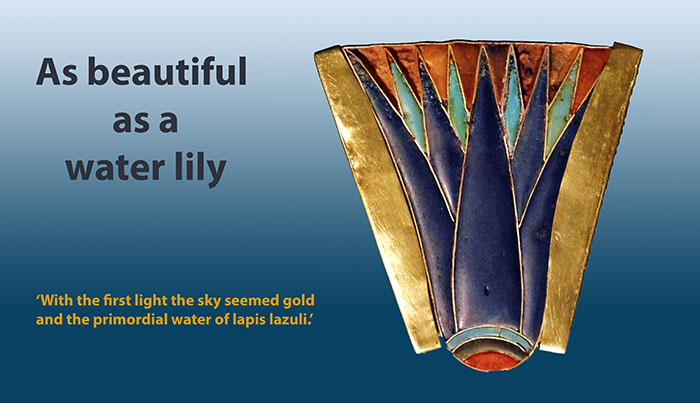
One of the most beautiful flowers that graced the Nile in ancient Egypt was the blue water lily. Every morning, at the first rays of the sun, the flower unfolds its petals. At night it closes, only to open again the next morning. The Egyptians soon saw that they could use this flower to explain something about nature. Where does all life come from? And what is the destiny of all these creatures? The Egyptians put their ideas into a myth, and although it is a few thousand years old, it reflects a very modern vision.
According to this myth, the blue water lily floats on the primordial water at the beginning of creation. Then at the first dawn, the flower buds. From its opened petals, the sun rises and then all beings unfold.
This first budding, this first beginning, is of great beauty. A hymn tells that the first light in the sky was like gold and the primordial water was like lapis lazuli.

What does this myth mean?
To understand Egyptian myths, it is good to first take a look at the living environment of the ancient Egyptians. Indeed, the Egyptians chose symbols from their environment. Egypt is a large country, but the habitable part covers only a small area. Most of Egypt is desert. Only in the narrow strip of land along the Nile and in some oases can people live. In the delta, where the river spreads wide, this area is larger.
There is almost no rain in Egypt. All life depends on the Nile. This river overflowed its banks every year. This provided not only water, but also fertile soil. After each flood, when the water receded, the Nile left behind fertile silt on which all plants could grow. Today, the Nile no longer floods. The water has been regulated to pass through since the high dam in Aswan in 1971, and earlier to a lesser extent (small dam 1902).
But before then, the Nile flood was essential to all life for thousands of years. Therefore, it was obvious that the Nile, with its flooding, would also play an important role in myths.
The Egyptians also chose animals and plants from their habitat as symbols in their myths. They chose exactly those animals and plants best suited to express something. The colors the Egyptians saw every day also play a symbolic role in myths. Blue is the color of the sky and of water. Green the color of growth and new life. Gold is the color of the sun and red can also represent the sun. Black is the color of fertile Nile clay. The Egyptians called their land Kemet, “the black land,” named after this fertile Nile clay. Kemet is the land on which everything can grow and flourish.

Who came up with these myths?
All Egyptian myths were devised by the priests. A priest in ancient Egypt is not the same as we understand a priest today. It is just a word we give to it now. Egyptian priests were scientists and even more than that. They were designers, philosophers, mathematicians, doctors, astronomers, writers, teachers and architects. These people devised the myths and the figures of the gods. They also designed the statues, jewelry, paintings, temples and books of the dead. All these works of art are closely linked to myths. Myths are not just stories, but hide a deeper content.
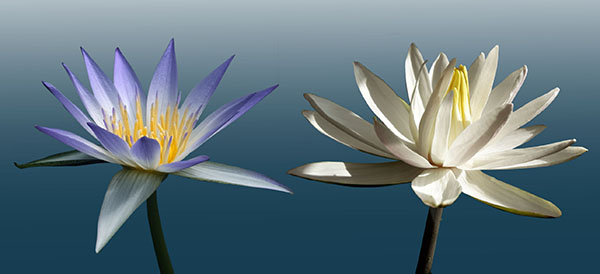

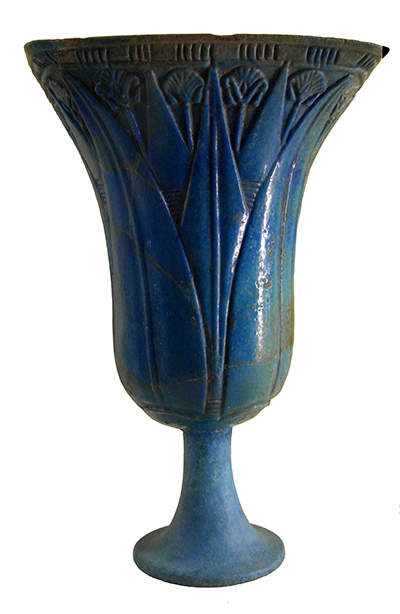
Primal
These priests/philosophers had clear ideas about how the world of forms arises, how from energy or consciousness matter arises. They had insight into nature, insight into consciousness, insight into the purpose of life. According to them, before there was anything, before the earth came into being and the trees were there, there was an indescribable principle of life that extended into infinity. The Egyptians called this the primordial water, Nun. Nun is not really water, but infinite life; consciousness.
Nun is always there. It is there before a world is created and is there even when this world has form. It is around all beings and through all beings. All living beings emerge from it.
Egyptian priests were looking for ways how best to explain this idea to people now. They saw the Nile Flood, a period when all the land was flooded. There was then only water, nothing else. They understood that this was a wonderful symbol for Nun. When the water receded some time later, plants sprouted from the fertile earth, birds perched on them, frogs emerged, and other animals followed. And even the water itself was full of life.
In myth, the water lily represents a place in the primordial waters, a swirl in an infinite field of energy. The flower’s blue color is the color of infinity, the color of the primordial waters. It is also the color of the sky. The sun or sun god that emerges from it can be thought of as a core of life that becomes active. It is a point or center in the primordial water, still without form; a center of consciousness. From this center, a stream of consciousness flows, shaping all levels of existence. It flows from the divine to the human, then on to the animal and plant levels, all the way to the mineral level.

Network
Everything around you, according to the Egyptians, consists of living beings. Humans, animals and plants are alive, but matter is also alive.
They did not know the word atom, but many clues indicate that they assumed that matter consisted of living particles. Even the stars and planets, according to them, are forms of life.
All these living things work together and form one big network. Nature, according to the Egyptians, is constructed as life within life. Humans need smaller beings like cells and atoms to build their bodies. These cells and atoms are also living beings with their own inner core. They may be little conscious yet alive. Humans, in turn, live in the sphere of the earth. The earth in turn lives in the solar system and the solar system in the galaxy. Thus all beings live in the field of a greater being.
In some amulets, this idea is well seen. In this eye of Ra (Fig. 3), many smaller eyes of Ra are depicted. The eye of the sun god (Ra) is one of many symbols for the sun god. From its tears, according to a myth, living beings flow. The color of the amulet is blue after the color of primordial water.
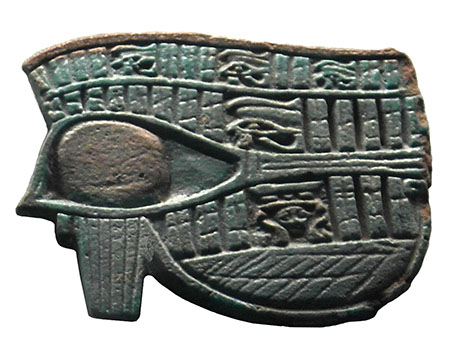

Remarkable
Egyptian priests devised many different creation myths. In all these creation myths, the story is different, but all have the same meaning. The sun god is represented by a different symbol in each story, but all these stories start from the primordial water and from the sun or sun god emerging from it. From the sun god all beings then emerge.
Probably the Egyptian priests devised so many different creation myths so that people would not take them literally. Moreover, the stories are so curious that there had to be a deeper meaning behind them. And as curious as the stories are, so are the works of art that express these myths. Thus, these remarkable objects and stories invite you to discover deeper layers of meaning.

Cyclic appearance and disappearance
According to the Egyptians, all beings not only emerge from the primal waters, but also return to them. During sleep, consciousness retreats further and further, and in the deepest part you can enter an area or sphere of consciousness adjacent to the primal waters. Upon awakening, consciousness returns to the outside world. During death, exactly the same thing happens. Then, too, consciousness retreats further to a deeper level. At a new birth, consciousness again turns toward the outer world and forms a new body. Life unfolds again. Average people do not experience this consciously. They have no memory of it. And yet………
In the sarcophagus texts, the sun god says that one of his good deeds is that he made people so that everyone remembers in their hearts “the beautiful west”-heaven. Somewhere there was a memory of a magnificent atmosphere of unity and happiness. To this happiness all people long to return. Egyptian texts speak of people’s desire to be able to “see the sun god” and stay in the beautiful areas of Hathor. According to these texts, there were people who could do this, not during death, but during their lifetime.
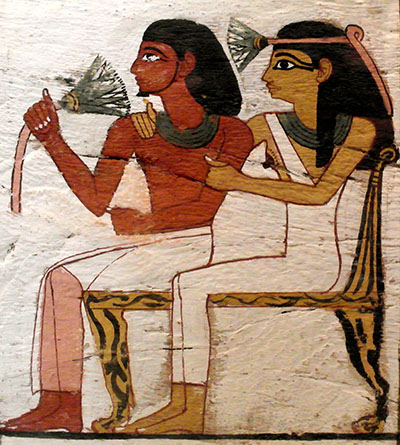

Fig. 6 Tutankhamun appears from a water lily. Egyptian Museum Cairo. (Photo O.k. From collection of Corina Zuiderduin)

As beautiful as a water lily
Egyptian texts give the impression that man once emerged unconsciously from this high plane. He can return to it by developing character traits that belong to this sphere. Each lifetime a person can further develop his character – make it noble – until it is as beautiful and pure as a water lily. You are then, “ennobled like a god,” as the Egyptians say, and become the sun god himself. In a spell from the Book of the Dead, the Egyptian says:
‘I am this pure water lily, which sprang from the sunlight. Who is at the nose of Ra. For I am the pure water lily that resulted from the primordial water.’

Together
Remarkably, the same idea is also found in Hinduism and Buddhism. According to Hinduism, prior to creation, Vishnu sits on a golden lotus on the primordial water. The lotus is a symbol of purity and the true nature of all beings. The flower also symbolizes a state of consciousness through enlightenment. In Buddhism, we find a similar idea: the lotus is the seat of the Buddha. It is his abode, his state of consciousness.
When you have developed everything you can develop as a human being and you have allowed the inner god to blossom, you have reached an end point. This stage of beauty and happiness is not a final end point, but a relative end point. Noen is infinitely deep. You can always go further. There are always higher steps to be reached, more beautiful vistas to be discovered.
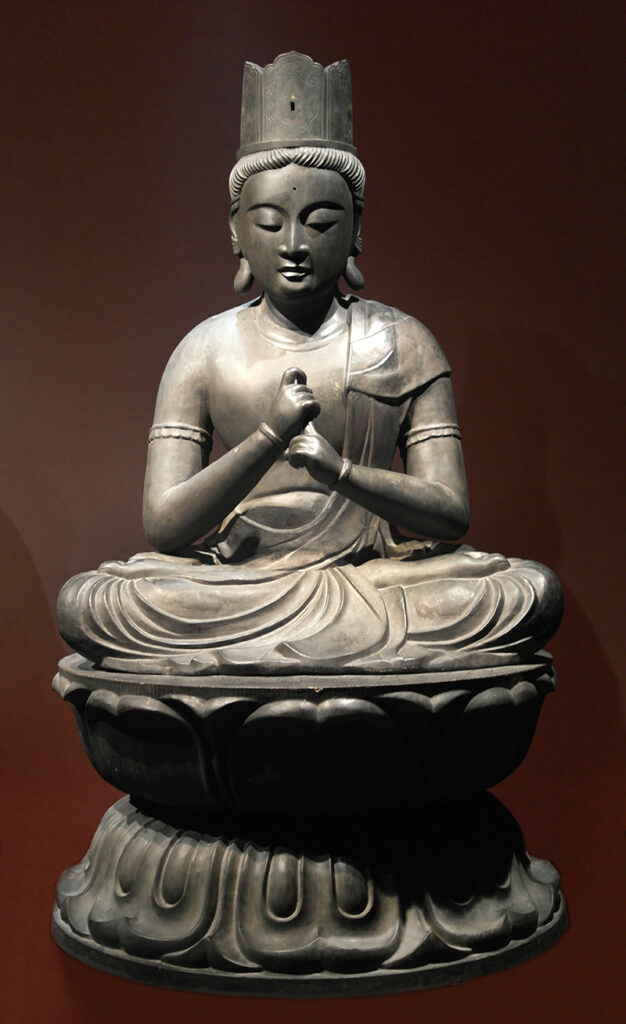
Fig. 7 Buddha on a lotus flower. The lower part of the base represents the flower’s reflection in the heavenly water. Museum of Ethnology, Leiden. (photo Corina Zuiderduin)

According to the Egyptians, you can only develop with each other. Only by interacting with others can you gain experience and learn. Figure 7 shows a gold water drop. Originally it was inlaid with colored glass. The red glass can still be seen as well as some traces of blue at the top near the water lily. The king’s name is shown in hieroglyphics.
Every being is a drop of primal water, a drop of infinity. All beings are different. No two beings are exactly the same. And yet, at their deepest core, all beings are one. It is precisely because of the differences that you can learn from each other. You always develop together, with and through each other.
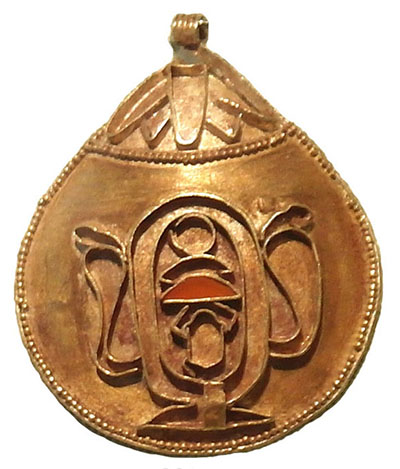

This article is an adaptation of an article that appeared in Bresmagazine april 2022 and on the book het Mooie Westen, mythen en symbolen in Egypte (2019).
Copyright text and photos: Corina Zuiderduin